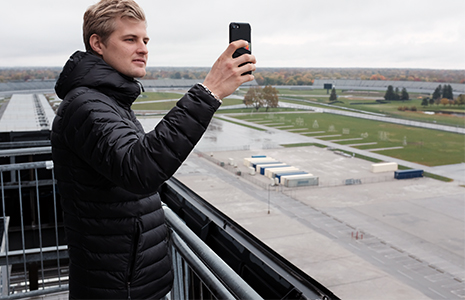Marcus Ericsson isn’t shy when answering the question about the depth of his oval racing experience during his international career.
“Zero,” Ericsson said with a chuckle.
Ericsson knows he is starting from scratch on circle tracks in 2019 as he makes the transition from Formula One to the IndyCar Series. The 28-year-old Swede was named Oct. 30 to drive the No. 7 Honda entry fielded by Schmidt Peterson Motorsports full time next season, alongside teammate James Hinchcliffe.
The first scheduled oval race of Ericsson’s career also happens to be the biggest race in the world – the 103rd Indianapolis 500 on May 26 at Indianapolis Motor Speedway. That’s a big leap into the deepest end of the pool.
“I think you need to go into it very open-minded and sort of take it step by step,” Ericsson said. “I’m lucky to have such a good team around me with SPM. They will help me get up to speed and with James as a teammate, I think that will help as well.”
Ericsson, a native of Kumla, Sweden, competed in a variety of global open-wheel road-racing series before climbing to F1 in 2014 with the Caterham team. He moved to Sauber in 2015 and is finishing his fourth season with the team this year.
He started his career in Sweden through karting, receiving backing to make the transition into cars from 1999 Indianapolis 500 winner and fellow Swede Kenny Brack, who was impressed with Ericsson’s speed as a youngster.
Ericsson climbed to car racing in 2007 in the Formula BMW UK open-wheel series, winning the championship for Fortec Motorsport with seven wins and 11 poles in 18 starts. He finished fifth in the British Formula 3 Championship with Fortec in 2008 before winning the All-Japan Formula 3 Championship with the TOM’s team in 2009.
 That success helped Ericsson land a ride in GP2 – the last step on the ladder before Formula One – in 2010. He won two races in his three seasons in that championship before reaching F1 with Caterham in 2014.
That success helped Ericsson land a ride in GP2 – the last step on the ladder before Formula One – in 2010. He won two races in his three seasons in that championship before reaching F1 with Caterham in 2014.
There is one aspect of Ericsson’s driving style, from karts all the way to F1, that he thinks will help him succeed in Indy car oval racing.
“That’s always been one of the big things of my driving style, that I’m very smooth,” Ericsson said. “I remember when I was in go-karts when I was a kid, people would say they would watch me and say when I was alone on track that it looked like I was going super-slow because I was so smooth out there on track. Then when you asked me the time, I was the fastest.
“So I think already from when I started, I’ve always been a smooth driver. But later in my career, I sort of learned to switch on the aggressive side, as well, when needed. Hopefully that will help me on the oval side.”
Unlike some European open-wheel converts to Indy car, Ericsson is relishing the challenge of turning left only, especially during the month of May.
“I’ve always been really interested in oval racing because since I started my career, it seems like high-speed cornering and high-speed turns always have been my favorite and where I’ve always been super-strong compared to my teammates,” Ericsson said. “I always wondered how I would go on an oval because I think my type of driving would suit an oval. Obviously, it’s very different to a normal, high-speed turn, but I feel like it’s something I will like and, when I get used to it, will be quite good at it. I hope so, at least!”
Ericsson is talking with as many people as possible as he prepares for arguably the biggest switch of his racing career – Schmidt Peterson officials, Hinchcliffe, friend and former F1 driver Alexander Rossi and more. He also hopes to test as much as possible on an oval before May and plans to do as much simulator work as he can. It’s all part of flattening the learning curve.
Ericsson also sought and received advice from someone probably more qualified than anyone about making the current transition from F1 road racing to Indy car oval racing – two-time F1 champion Fernando Alonso, who electrified the racing world with his strong oval debut in the 2017 Indianapolis 500.
“I spoke to Fernando a couple of times,” Ericsson said. “I just asked Fernando what he thought about it, and he said it was an amazing experience, that it was so much fun. Fernando only had positive things to say about it, and he said it’s such a cool way of racing and that you will love it. When I speak to other drivers and people in the business, everyone is saying so many positive things about INDYCAR at the moment.”
Tickets for all May 2019 events at Indianapolis Motor Speedway, including the sixth annual INDYCAR Grand Prix and the 103rd Indianapolis 500, are on sale now at IMS.com.
The 2019 IndyCar Series season consists of 17 races, beginning with the Firestone Grand Prix of St. Petersburg on March 10. All races air live on NBC or NBCSN, as well as the Advance Auto Parts INDYCAR Radio Network.